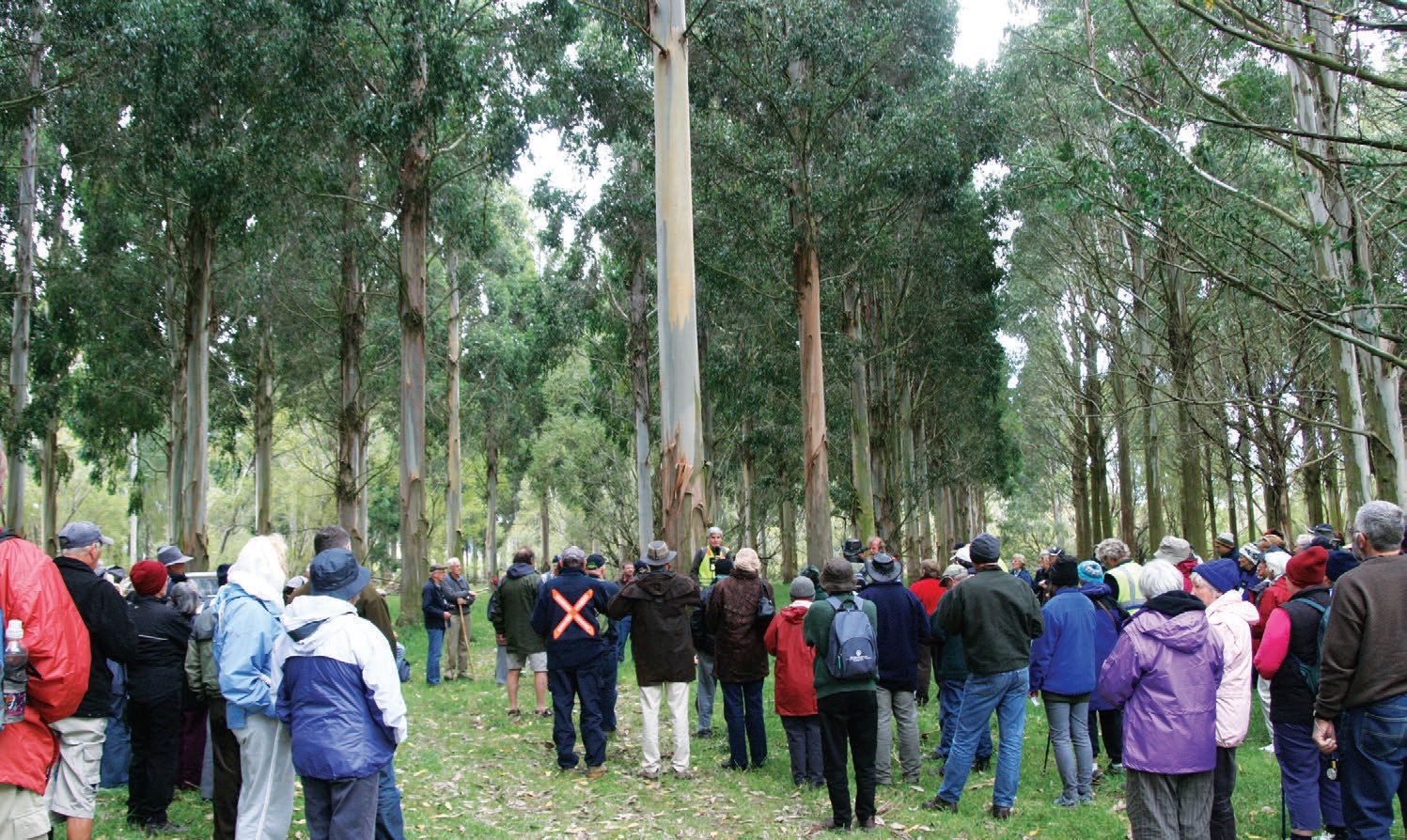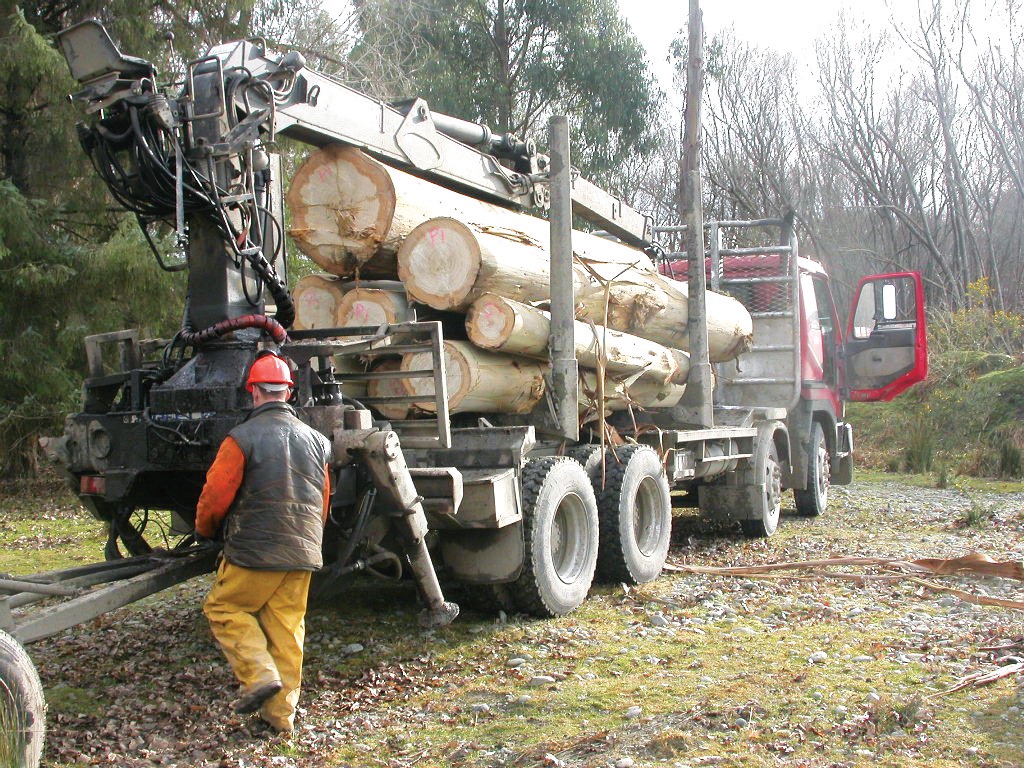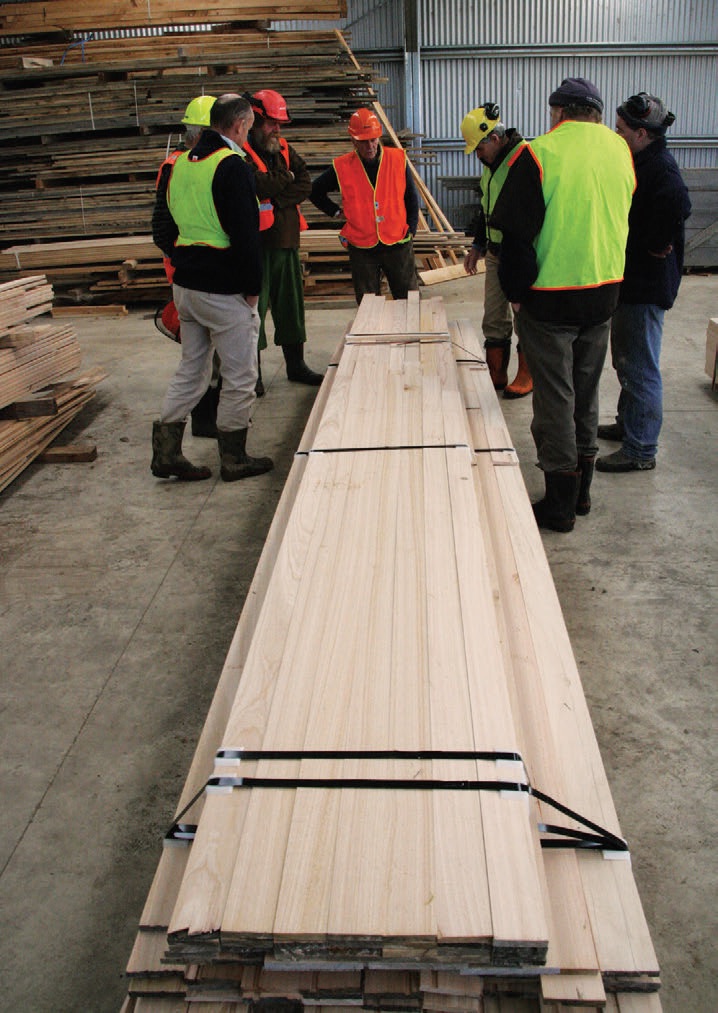A love affair with eucalypts
Graham Milligan, New Zealand Tree Grower August 2010.
One of the characteristics of the dedicated farm forester is enthusiasm in attempting to grow a wide range of species outside the ubiquitous radiata pine. This has manifested itself in the special purpose groups within the NZFFA where enthusiasts of a particular species can share experiences with those of like mind and hopefully grow these species at profit.
I was no exception in dabbling in other species. Blackwood, Acacia melanoxylon, was an early attempt, but our southern winter frosts soon put an end to this. I have my share of cypress of various varieties and have cattle yards and a shed built from opportunistic logs that were harvested from macrocarpa trees of some vintage that were inherited with the property. Poplars were widely planted and the hybrid Androscoggin – a cross between Populus trichocarpa and P. maximowiczii, has proved that its outstanding growth has not been to the detriment of producing excellent timber which we have been selling over the last couple of years.
Making a dollar or two
My true arboreal love affair, however, is with the eucalypts. We have some large 100 year-plus Eucalyptus archerii, E. coccifera and E. urnigera growing on the property, and my father dabbled in E. ovata, E. regnans and E. nitens from long lost provenance sources. It was the E. regnans and E. nitens he planted that piqued my interest in these species.
With known and well recorded solid timber attributes from Australian natural forests, and with these two species showing vigour and health here, it seemed a good idea to plant more of them and hopefully make a dollar or two at point of harvest.
The original E. nitens trees on our property appear to be the oldest of the species in this part of the world, although I realise the use of superlatives is a good way of being usurped. The trees were planted in the early 1960s and many were killed by an errant spraying contractor whose philosophy was that Tordon would kill the weeds but would not harm the trees. Unfortunately this fallacy still exists today and we regularly see shelter belts annihilated by herbicides liberally applied to an adjacent gorse bush – but I digress.

Wide space planting
In 1986 we set aside a paddock adjacent to the Oreti River to plant E. regnans and E. nitens in a regime clearly explained in that historic tome Growth habits of the Eucalypts by M R Jacobs, published in 1955. In the book, Jacobs tells how to plant eucalypts in a plantation and manage it to maximise growth rates, at the same time enhancing the quality of sawn wood that the trees will eventually yield.
Put simply, the concept involves planting the trees at relatively wide spacing − we planted in rows 10 metres apart − and selecting the final crop as soon as practicable with the final crop of around 100 stems a hectare at relatively even spacing. We achieved our final crop at year six – with slightly higher stocking at around 120 stems per hectare and pruned ours to over six metres. The now 24-year-old trees were visited during the 2010 conference and I think most people were impressed at how visually appealing the stand of trees is. We achieved a lot of livestock grazing under the trees in the early years and the grass is still growing underneath, although grazing is now somewhat limited.
A challenge
The big challenge for us here was what the timber was like. We had done a trial sawing from another block previously and the resultant timber was quite impressive. All the way through the rotation, however, we were bombarded with negativity about the eucalypts as a solid wood crop. Discussion in the Tree Grower was rarely positive. Comments such as ‘you have to grow them for a least 30 years to get a decent sized log’ to ‘you cannot get a decent board due to collapse-warping’ tends to dampen enthusiasm. The great radiata promotion ground relentlessly on and sawmillers’ description of eucalypts involved a few dismissing words, most of them expletives.
The one outstanding positive beacon in those early years was Dudley Franklin and his encouragement, based on sound scientific research. That early catalyst that was needed and in later years, to see the E. nitens that Dudley has used in his house only added to my confidence in the future of the species for timber.
Harvesting
In early 2009 we harvested four 23-year-old trees from the block. They yielded 18.5 tonnes of sawlog and we split around six cubic metres of firewood from the tops and larger branches. This equates to over 500 tonnes of sawlog per hectare. Bevan West’s sawmill at Branxholme had asked for the logs as he has a special interest in eucalypt timber.

Bevan started in the sawmilling industry in 1994 with a portable mill. Three years ago he took the plunge in building a mill from scratch, which took a degree of courage considering the state of the industry. The construction is continuing and Bevan, like a lot of smaller sawmillers, also has a liking for macrocarpa. This resource has diminished rapidly and Bevan’s long interest in eucalypts has encouraged him to rely less on the commodity market of radiata pine and target niche markets with a better quality of timber.
He is not unique in this respect as many of the smaller sawmills in the south have had to specialise to stay in business. It is difficult to compete in the radiata market when your production of 12 cubic metres a day enters the market with the big boys producing around 700 cubic metres a day.
Milling
Twelve months after getting the E. nitens from us our forestry discussion group visited the mill and saw some packets of sawn timber from these logs, and we were all very impressed. So much so that one of our group, who was still sitting on the fence as to whether to replant his cut over pine block in radiata or E. nitens, is now firmly in favour of the latter.
Of course Bevan was quizzed as to how he achieved such a quality product, and here are some pointers he regards as compulsory:
- Trees should be over 30 years old but there was no problem with your 23-year-old trees as ‘you know how to grow eucalypts’
- You have to be able to ‘read’ the log when milling.This is hard to quantify, does not necessarily involve quarter sawing, but takes into account end splitting, which is inherent in eucalypts, and grain. I am sure Dean Satchell and Paul Millen can relate well to being able to read each individual log.
- The logs should be sawn at 4.2 metres in length and boards finished at 3.9 metres. This is normally dictated by end splitting which may require the ends to be removed.
- The boards should be cut as close as possible to 25 mm thick and 3 mm is dressed off each side to remove any potential imperfections such as cell collapse.
- The timber should be strip stacked and air dried for three to four months in an open-fronted shed without exposure to direct sun or wind.
- After air drying the timber should be dried in a dehumidifier kiln to about 40°C for a week or 10 days, then finally dressed.
Bevan achieves around 40 per cent yield of timber from logs sawn. But like all eucalypt sawmillers I have spoken to, he comes across the occasional rubbish log for which there seems to be no explanation.

Client for eucalypt timber
Bevan has a customer in Vietnam who has been purchasing radiata including old man pine with its striking grain pattern caused by resin. His client wants to get out of the radiata market, has seen the eucalypt, and wants supply immediately. The timber will be made into furniture for the Australian market and involves one container load a month, which equates to 150 tonne of logs a month. Bevan is currently sawing 40 year old E. delegatensis, not ours, also with excellent results and the very pale timber of these species lends itself well to staining to a colour of choice – an important point.
As a furniture manufacturer the client is not too concerned about smaller knots, as only small piece size is used. Any badly collapsed or warped timber, or very large knots, are sawn into railway sleepers for landscaping.
Money in firewood
Would I do anything different? No, except now I can use better genetics and hope the timber is just as good. As was pointed out during the conference visit, selling the crop as standing firewood is still very profitable at $20 per solid metre.
We hope to achieve $50 stumpage as a minimum. Along with grazing and potential carbon credits, this makes the regime much more profitable than any other forestry species we grow, including radiata pine.

 Farm Forestry New Zealand
Farm Forestry New Zealand